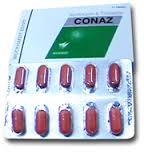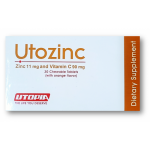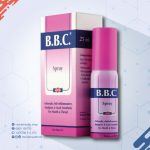
CONAZ
Norfloxacin and Tinidazole
COMPOSITION:
Each film coated tablet of CONAZ contains:
Norfloxacin U.S.P. 400 mg
Tinidazote B.P. 600 mg
DESCRIPTION:
CONAZ tablet is a combination of Norfloxacin, a potent antimicrobial agent and Tinidazole, an effective antianaerobic bactericidal agent plus being an effective amoebicidal agent, which rapidly eradicates. Entamoeba histolytica.
The combination in CONAZ ensures:
– Effective control of gastrointestinal infections due to susceptible pathogens including enteric fever and other Salmonella and Shigella species.
– Prompt control of diarrhea and dysentery dueto bacterial or amoebic inff!c.t.lPns
– Comprehensive bactericidal coverage including anaerobes gram-negative and gram-posrtlve- aerobics for treatment and prevention of infections due to these organisms; including dental infections like gingivitis, deep pockets, dental abscess and periodontitis.
INDICATIONS:
CONAZ (Norfloxacin and Tinidazole combination) is indicated in:
– Prevention and treatment of Enteric fever and other gastrointestinal infections due to susceptible organisms including Salmonella typhi and paratyphi sp.,Shigelia sp., Campilobacter jejuni, H. Pylori and enterotoxigenic E. cofi..
– Diarrhea and dysentery of bacterial, amoebic, or of mixed origin.
– Prevention and treatment of infections due to gram-negative and several gram-positive aerobic organisms and/or anaerobic organisms after surgical or dental procedures.
– Prevention of infections in immune-compromised patients.
– Treatment of urinary tract infections and both of Gonococcal and Non Gonococcal infections’.
– Treatment of bacterial vaginosis, pelvic inflammatory disease and trichomoniasis.
CONTRAINDICATIONS:
– Norfloxacin and Tinidazole combination tablet is contraindicated in patients with history of hypersensitivity to Noriloxacin or other quinolones and to Tinidazole in patients having history of convulsive disorders.
CONAZ is contraindicated during pregnancy and in nursing mothers.
CONAZ is contraindicated in children before puberty.
WARNINGS:
– Serious and sometimes fatal events, some due to hypersensitivity, and some due to uncertain etiology,have been reported rarely in patients receiving therapy with quinolones including Norfloxacin.
– These events may be severe and generally occur following the administration of multiple doses.
– Clinical manifestations may include one or more of the following:
1- Fever, rash or severe dermatologic reactions (e.g. toxic epidermal necrolysis, Stevens Johnson’s syndrome).
2- Vacuities Arthralgia, myalgia,serum sickness.
3- Allergic pneumonitis.
4- Interstitial nephritis, acute renal insufficiency or failure.
5- Hepatitis. jaundice, acute hepatic necrosis or failure.
6- Anemia, including hemolytic and aplastic thrombocytopenic purpura, leucopenia, agranulocytosis, pancytopenia and/or hematologic abnormalities.
7- Exacerbation of myasthenia gravis: Fluoroquinolones have neuromuscular blocking activity and may exacerbate muscle weakness in persons with myasthenia gravis. Postmarketing serious adverse events, including deaths and requirement of ventilator support, have been associated with tluoroquinolones use in persons with myasthenia gravis. Avoid tluoroquinolones in patients with known history of myasthenia gravis.
PRECAUTIONS:
1- Moderate to severe photosensitivity reaction.
2- The Risk of serious tendon disorders with quinolones is higher in those over 65 years of age and those who are using corticosteroids.
3- Geriatric use: in general, elderly patients may be 1)10re susceptible to dwg-associated effects of the aTC interval. Patients over 65 years are at increased risk for developing severe tendon disorders including tendon rupture when being treated with a f1uoroquinolone antibiotic such as Norfloxacin.
SIDE EFFECTS:
It may cause nausea, vomiting. unpleasant taste and gastrointestinal disturbance occasionally in few susceptible Individuals. Central Nervous System (eNS) effects such as dizziness, headache and drowsiness may also occur.
Visual disturbances may occur in few susceptible patients following administration of Norfloxacin, however the effect is reversible. Allergic reactions such as rash, urticarial. pruritus and angioedema have been reported in susceptible
patients. On rare occasions, convulsions and blood dyscasias have been reported in patients receiving Tinidazole and/or Nor11oxacin.
-Skin (Photosensitivity. photoxicity reactions) & Hepatic (Hepatic failure, including fatal cases)
DRUG INTERACTIONS:
Serum concentrations and elimination half-life of theophylline may be Increased, when it is used concurrently with CONAZ. It is recommended that the patients be monitored for the signs of theophylline toxicity during concurrent use and dosage adjustments made as appropriate. Probenacid delays the excretion of Norfloxacin and Tinidazole. Antacids containing magnesium hydroxide and/or aluminum hydroxide may interfere with absorption of this combination tablet resulting in lower serum and urine levels. Concurrent administration of antacids with Norfloxacin and Tinidazole combination tablet should be avoided.
DOSAGE AND ADMINISTRATION:
The usual recommended dosage is one tablet twice daily for 5 days with or after food. Since the combination contains Norfloxacin, the patients should be advised to take adequate oral fluids.
PRESENTATION:
Boxes of 10 Tablets.
Boxes of 20 Tablets
STORAGE:
Store in a dry place at room femperature.
Keep out of the reach of children
Produced by:
Future Pharmaceutical Industries
For Wockhardt Egypt

